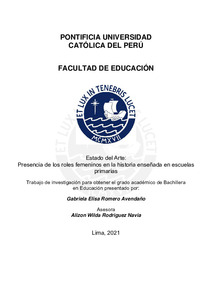| dc.contributor.advisor | Rodríguez Navia, Alizon Wilda | |
| dc.contributor.author | Romero Avendaño, Gabriela Elisa | |
| dc.date.accessioned | 2022-10-06T18:36:42Z | |
| dc.date.available | 2022-10-06T18:36:42Z | |
| dc.date.created | 2021 | |
| dc.date.issued | 2022-10-06 | |
| dc.identifier.uri | http://hdl.handle.net/20.500.12404/23468 | |
| dc.description.abstract | La enseñanza de la historia dentro del área del curso de Personal Social en escuelas
primarias ha estado centrada en modelos y paradigmas androcéntricos que han
inviabilizado la presencia de las mujeres como sujetos históricos. Las distintas
perspectivas curriculares no han podido responder en el desarrollo de las
competencias históricas de los y las estudiantes. Puesto que el currículo y la
enseñanza de la historia escolar han priorizado la incorporación de personajes que
respondan a valores nacionales de una nación, relegando así, los aportes de las
mujeres en la historia. En ese sentido, este artículo realiza una breve revisión
bibliográfica sobre la presencia del rol femenino en historia enseñada en las escuelas,
y así se analizarán las diversas aristas que han ocasionado la exclusión de sus
aportes. Desde los Estudios de Género se realizó una secuencia cronológica sobre la
relación entre los personajes invisibles de la historia y la historiografía feminista. Se
analizó e interpreto el rol del profesorado y los libros de texto como los principales
agentes en la reproducción de estereotipos y prejuicios. Se establecen algunas
tipologías curriculares y fases planteadas por diversos autores, dentro de los cuales
se plantea reestructurar los planes que definen el currículo escolar, lo que haría
posible la introducción de la presencia de personajes femeninos en las aulas de
escuelas primarias. En consecuencia, el presente recuento bibliográfico busca
fomentar la enseñanza de contenidos históricos desde una perspectiva de género en
las planeaciones curriculares, los materiales pedagógicos, las prácticas docentes, con
el fin de repensar los discursos y prácticas sociales que promuevan la inclusión,
empatía y el empoderamiento de las niñas. | es_ES |
| dc.description.abstract | The teaching of history within the area of the Social Personnel course in primary
schools has been focused on androcentric models and paradigms that have made the
presence of women as historical subjects unfeasible. The different curricular
perspectives have not been able to respond in the development of the historical
competences of the students. Since the curriculum and the teaching of school history
have prioritized the incorporation of characters that respond to national values of a
nation, thus relegating the contributions of women in history. In this sense, this article
makes a brief bibliographic review on the presence of the female role in history taught
in schools, and thus the various edges that have caused the exclusion of their
contributions will be analyzed. From Gender Studies, a chronological sequence was
made on the relationship between the invisible characters of history and feminist
historiography. The role of teachers and textbooks as the main agents in the
reproduction of stereotypes and prejudices was analyzed and interpreted. Some
curricular typologies and phases proposed by various authors are established, within
which it is proposed to restructure the plans that define the school curriculum, which
would make it possible to introduce the presence of female characters in primary
school classrooms. Consequently, this bibliographic recount seeks to promote the
teaching of historical content from a gender perspective in curricular planning,
pedagogical materials, teaching practices, in order to rethink social discourses and
practices that promote inclusion, empathy and empowerment of girls. | es_ES |
| dc.language.iso | spa | es_ES |
| dc.publisher | Pontificia Universidad Católica del Perú | es_ES |
| dc.rights | info:eu-repo/semantics/openAccess | es_ES |
| dc.rights.uri | http://creativecommons.org/licenses/by-nc/2.5/pe/ | * |
| dc.subject | Género--Perú | es_ES |
| dc.subject | Educación primaria--Perú | es_ES |
| dc.subject | Historia--Estudio y enseñanza | es_ES |
| dc.subject | Mujeres en la historia | es_ES |
| dc.title | Estado del Arte: Presencia de los roles femeninos en la historia enseñada en escuelas primarias | es_ES |
| dc.type | info:eu-repo/semantics/bachelorThesis | es_ES |
| thesis.degree.name | Bachiller en Educación | es_ES |
| thesis.degree.level | Bachillerato | es_ES |
| thesis.degree.grantor | Pontificia Universidad Católica del Perú. Facultad de Educación | es_ES |
| thesis.degree.discipline | Educación | es_ES |
| renati.advisor.dni | 08147009 | |
| renati.advisor.orcid | https://orcid.org/0000-0001-5399-1272 | es_ES |
| renati.author.dni | 70563827 | |
| renati.discipline | 199996 | es_ES |
| renati.level | https://purl.org/pe-repo/renati/level#bachiller | es_ES |
| renati.type | https://purl.org/pe-repo/renati/type#trabajoDeInvestigacion | es_ES |
| dc.publisher.country | PE | es_ES |
| dc.subject.ocde | https://purl.org/pe-repo/ocde/ford#5.03.01 | es_ES |






